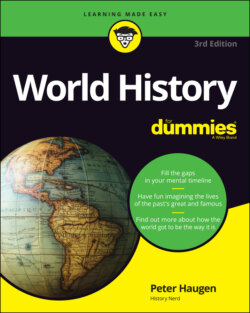Читать книгу World History For Dummies - Peter Haugen - Страница 26
Reading the Body Language of the Dead
ОглавлениеSome people who lived hundreds or thousands of years ago left more than just their images in sculpture and paintings on stone. Preserved bodies are in-the-flesh evidence of long-ago reality. The mere fact that a human body from thousands of years past is still more or less intact and recognizably like this year’s model can help open your mind to the connection between then and now. Something about a mummy helps your imagination bridge all the generations since that puckered flesh was taut, upright, and dancing.
In history books that cover big expanses of time, you have to adjust your perspective so that a century becomes a relatively small unit of history. In this book, you can breeze through a thousand years here and a thousand years there. Thinking of the Byzantine Empire as one civilization, a single station on the history train, is easy to do. Yet the empire grew and receded, changed governments, and restructured policies over centuries — more than five times longer than the United States has been a nation.
When you back up far enough to take that concept in, you may lose sight of individual lives, which flicker past quickly. I find that contemplating mummies is a helpful, if gruesome, tool for hooking into the perspective of a single life span, a single person, so long ago. Strangely, you may be able to identify with a mummy easily, if you don’t find the idea too macabre.
Mummies have turned up all over the world. Some were preserved naturally by something in the environment where the body came to rest. Others, as in the celebrated tombs of ancient Egypt, were artfully prepared for their voyage into death.
